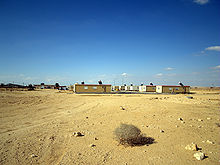- Blueprint Negev
-
Blueprint Negev is a Jewish National Fund (JNF) project to develop the Negev region of Israel.
The project aims to increase the Negev's population by 250,000 new residents, improving transportation infrastructure, adding businesses and employment opportunities, preserving water resources and protecting its environment.[1] The project aims to reduce the strain on Israel's coastal strip, which is suffering from overdevelopment and overpopulation. 92% of Israel's population resides on 40% of Israel's land, while only 8% of its population lives in the Negev, which represents 60% of Israel's landmass.
Contents
History
The last large-scale development project to accommodate and promote new Jewish immigration was during the 1980s, when "Operation Promised Land" was launched to meet the challenge of the massive upsurge of Jewish immigration from the Soviet Union and Ethiopia.
In May 2006, Peres said that his first task as Minister of Development of the Negev and Galilee would be to promote the construction of a new Jewish community in the Negev, Karmit, the first to be built under the Blueprint Negev plan after Be'er Milka.[2] Ynet reported that the community was "designated for wealthy, young American immigrants who want to make aliyah and live in style."[3] Former JNF President, Ronald Lauder said that Blueprint Negev answers the need for Jews looking to make aliyah the pioneering way.[4]
Population redistribution
The plan aims to bring 250,000 new residents to the Negev over ten years. Toward that goal, the project has sought to direct Anglo (English-speaking) immigration to the Negev and has compiled a database (currently containing some 10,000 names) of current Israeli citizens interested in relocating to the Negev. After the Disengagement, the JNF was instrumental in helping Gaza evacuees find new homes in the Negev as cohesive units.[5][6]
Beersheba redevelopment
The plan aims to increase the population of Beersheba, the Negev's largest city. One of the main projects undertaken there is the Be’er Sheva River Walk, creating a 900-acre (3.6 km2) park inspired by San Antonio’s River Walk.[7] The plan includes green spaces, an amphitheater for events, a lake for boating and promenades for strolling. The JNF supported cleanup of the riverbed.
New suburban communities
The plan envisions the creation of 25 new suburban communities.[4] Seven communities that have already been established are Sansana (1999) 54 families, Tzukim (2001) 72 families, Merchav Am (2002) 34 families, Giv’ot Bar/Shomria (2004) 30 families, Haruv (2005) 30 families, Be'er Milka/Kmehin (2006) 12 families, Karmit, and Kasif.[8] Sansana is part of the Har Hebron Regional Council governing Hebron-area settlements.
Environmental and social criticism
Israeli and American environmental groups are concerned that the creation of isolated suburban communities in the Negev will lead to water and energy intensive suburban sprawl and strain Bedouin-Jewish relations. They argue that the planned developments will require a large public investment per capita that benefits a small number of comparatively well-off immigrants in a region with high poverty rates.[9]The environmental justice organization Bustan is concerned that the Blueprint Negev's green gestures may be cosmetic at best, or mere rhetoric ( "greenwashing"). Bustan and religious Jewish organizations concerned with Jewish justice principles such as Neohasid[10] are concerned that if implemented, the plan’s rapid development will overbuild the country's last open spaces and eliminating the last vestiges of the Bedouin way of life. Bustan argues that the Blueprint Negev is an attempt by a wing of the American Jewish community to combat what they perceive as a "demographic threat" to Israel's Jewish majority, represented by the fast-growing Bedouin population. [11] Daniel Orenstein claims the project is not the answer to overdevelopment in the north. [12]Blueprint Negev is accused of discriminating against Bedouins and endangering their way of life. [13]
References
- ^ THE 12 POINTS OF BLUEPRINT NEGEV
- ^ JNF Update: creating new communities
- ^ Ynet on Peres' plans
- ^ a b Blueprint Negev
- ^ "Jewish National Fund Responds Again for Gaza Evacuees"
- ^ "JNF Works to Make New Homes for Gaza Evacuees"
- ^ Jewish National Fund plants an emissary in Bay Area
- ^ JNF Update: Creating new communities
- ^ When an 'ecological' community is not
- ^ Save the Negev
- ^ A Desert Mirage: The Rising Role of US Money in Negev Development
- ^ Daniel Orenstein. "Population Growth and Environmental Impact: Ideology and Academic Discourse in Israel", Population and Environment Volume 26, Number 1 (September, 2004)
- ^ The Forward: A JNF Drive To Make the Desert Bloom Means Destruction for a Bedouin Village
External links
Categories:- Environment of Israel
- Israeli society
- Land management
- Negev
Wikimedia Foundation. 2010.


